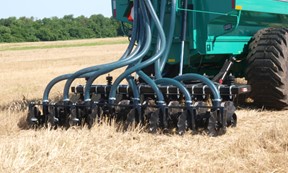Is Manure a Fertility Option for Wheat?

With ground opening up for manure application following wheat harvest, this is a good time to ask about the fit for manure with wheat? There are some good opportunities to use manure following wheat harvest.
Take Home Messages:
There are some situations when manure will work well in wheat rotations and others that should be used with caution. Here are a few “Rules of Thumb” to follow.
- Soil and manure sampling (extension publications G1740 and G1450) is essential for manure use in all crops;
- Manure before wheat:
- Use manure as a substitute for commercial phosphorus (P) fertilizer targeting those field with less than 25 ppm soil P levels (Bray test);
- High ammonium-nitrogen (N) manures (e.g. swine manure) injected into the soil can meet the N needs of wheat;
- High organic-N manures (e.g. beef open lot manure) may require a spring top-dressing;
- Manure after wheat and before corn:
- High organic-N manures can be applied in late summer;
- Delay application of high ammonium manures (liquid swine) until late fall, possibly considering a nitrification inhibitor.
- To get the highest return from manure, plan first to use in fields/crops requiring P and avoid building soil P beyond 50 ppm levels to protect the environmental.
Let’s discuss these in more detail.
Manure Before Planting of Wheat
If manure is being considered ahead of fall planting of wheat, manure can be an excellent source of P for achieving optimum yields. Phosphorus increases tillering in the fall resulting in increased number of heads and grain yield. Typically, optimum soil P levels for wheat are 25 ppm (Bray test) and 15 ppm for corn and 12 ppm for soybeans (EC155, Nutrient Management for Agronomic Crops in Nebraska). If field P levels have been maintained for corn and soybeans, manure can be an inexpensive way to raise soil P levels for wheat. Roughly, 18 lbs. of phosphate as P205 (or about 0.8 tons of beef feedlot manure – see table) would be needed per acre to raise soil P levels 1 ppm in the top 6 to 8 inches.  To raise soil P level from 15 to 25 ppm would require about 8 tons of beef feedlot manure per acre.
To raise soil P level from 15 to 25 ppm would require about 8 tons of beef feedlot manure per acre.
University of Nebraska N recommendations for wheat (Fertilizing Winter Wheat – EC 143) considers price of N and wheat as well as residual soil nitrate levels. Sixty to 90 lbs. of N per acre would be typical for today’s wheat prices. Nitrogen demand is highest in April and May growth and grain fill.
To meet N needs, a manure high in ammonium-N (e.g. pig finisher manure – see table) applied in late summer would be preferred pre-plant option. Manure ammonium-N would be available to wheat similar to a commercial N pre-plant application. Typically, swine finisher manure that is directly injected at a rate of approximately 2,000 gallons per acre would meet wheat’s N requirements (see table). Injection is essential for conserving the ammonium-N.
Manures with N in the organic-N form (e.g. beef feedlot manure) will be less reliable at meeting wheat’s spring N requirements. Typically we assume that 25 to 35% of the organic N becomes available to a corn crop during the warm growing season. However, cool spring soil conditions may not convert organic N to plant available N until too late for the plant. If beef feedlot manure or broiler litter is used for a wheat fertility program, spring topdressing with a commercial fertilizer should be considered.
Manure After Wheat Harvest
July harvested wheat followed by a spring planted corn or grain sorghum provides a long window for manure application that can meet next year’s N and P requirements. For these conditions, a late summer application of manure high in organic-N would be acceptable. Most of that organic-N would be available for next year’s corn crop. However, a late summer application of manure high in ammonium-N presents a high risk of leaching N out of the root zone before the next crop. Application of high ammonium-N manures should be delayed until after November 1. Nitrification inhibitors may have some value for mid-fall application of high ammonium-N manures but unlikely to be of value for late-summer manure application.
Manure can be a good fit with wheat in the circumstances discussed previously. Manure can deliver significant economic value based strictly on its nutrients (see figure), especially in situations that need supplemental phosphorus. Additional value also comes from manure’s organic matter which improves soil quality and represents manure’s greatest advantage over commercial fertilizer (see Finding Win/Win Opportunities for Manure). A little advanced planning will capture manure’s organic and nutrient value while preventing a bad experience for manure in wheat.
This article was reviewed by Nathan Mueller, Karen DeBoer, and Brian Krienke
Sign up for updates from UNL Water
